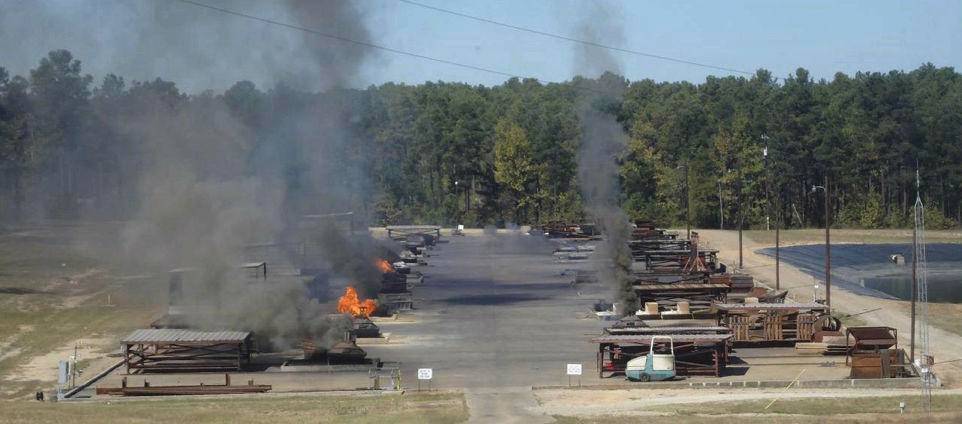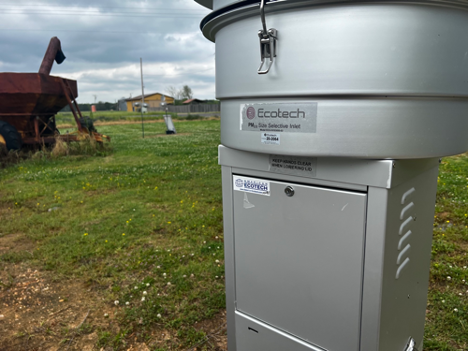LSU SRP Continues to Work with Community on Air Quality and Health: Update for Colfax, Louisiana

Open burning of waste at the Clean Harbors facility near Colfax, Louisiana. Photo source: Louisiana Environmental Action Network.
Louisiana State University Superfund Research Program (LSU SRP) researchers have been working with community members to understand the impacts of air pollution in and around Colfax, Louisiana, since 2020, after local residents organized into the Central Louisiana Coalition for a Clean and Healthy Environment and, citing health issues and other pollution-related concerns, requested assistance from the LSU SRP. After nearly 40 years of living adjacent to the last commercial open burn/open detonation thermal treatment facility in operation in the United States, the community is soon to see a major shift.
Colfax is a small, majority Black town northwest of Alexandria located near Clean Harbors Colfax, a commercial open burn/open detonation thermal treatment facility that processes a range of energetic and explosive hazardous waste materials, including from Superfund sites. Now, following a change in the hazardous waste permit issued to the facility by the Louisiana Department of Environmental Quality on June 29, 2023, open burn and open detonation will be prohibited at Clean Harbors by the end of 2023. To continue operations, the facility will have to switch to a closed burn system, filtering pollutants created when burning waste. Continual monitoring will have to demonstrate that emissions are below certain new air pollution limits established by the Louisiana Department of Environmental Quality.
Jennifer Richmond-Bryant, PhD, Associate Professor of the Practice in the Department of Forestry and Environmental Resources at North Carolina State University and Leader of the LSU SRP “Hazardous Waste Thermal Treatment and Community Exposure to Environmentally Persistent Free Radicals” project (Project 3) has led the LSU SRP team’s efforts to study the effects of open burning around Colfax.
According to Dr. Richmond-Bryant, this shift represents a positive change for the community. “Prohibition of open burning will make a huge difference for the people living in The Rock community adjacent to the facility’s property, who have suffered enormously from repeated exposures to harmful chemicals in munitions and other wastes,” she said.
Dr. Richmond-Bryant’s team has conducted a mixed-methods, community-integrated geographic information systems study on human exposures and health in Colfax. The team is currently in the process of developing a mobile app to communicate air sampling data to community partners and collect data on community members’ health and pollution observations. The Project 3 team has also worked extensively to characterize Colfax residents’ environmental exposures to environmentally persistent free radicals (EPFRs) and other pollutants through air monitoring across 10 sites within 10 miles of the open burn waste disposal facility.

Air sampling equipment set up at a household in the Colfax community.Photo Credit: LSU SRP Project 3.
The LSU SRP team is continuing to work with the Colfax-area community to study environmental exposures and health impacts through field measurements, integrating first-hand citizen experience with air pollution surveillance. As part of these efforts, Dr. Richmond-Bryant returned to Colfax in August to collect dust, urine, and toenail samples from households in the area, primarily within a 5-km radius of the waste disposal facility. A return trip is planned for November to collect additional samples. Dr. Richmond-Bryant stressed the importance of the LSU SRP team’s continuing work in this context:
“Vigilance is still needed. Construction is likely to reintroduce chemicals deposited onto soils and dust into the atmosphere, and even the closed burn facility will have some emissions. Our goal is to continue supporting the Colfax community by providing data that local residents can use to understand and mitigate their risks.”